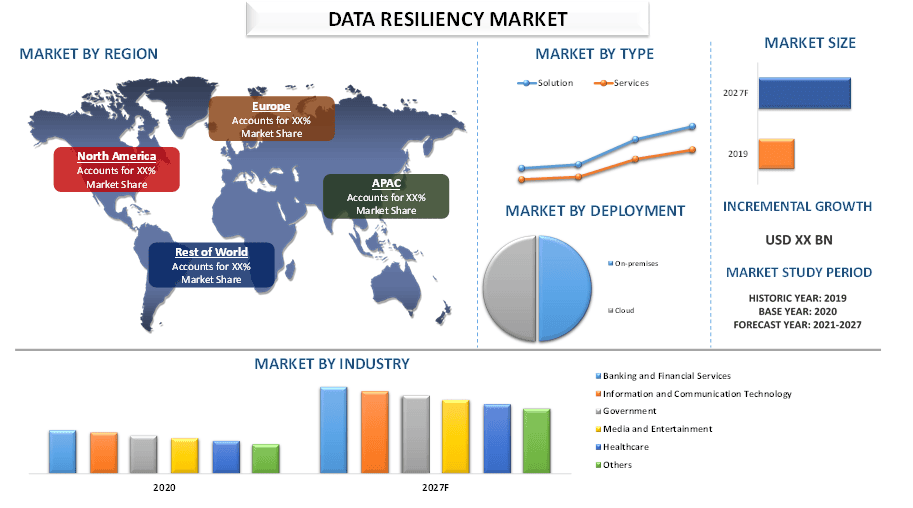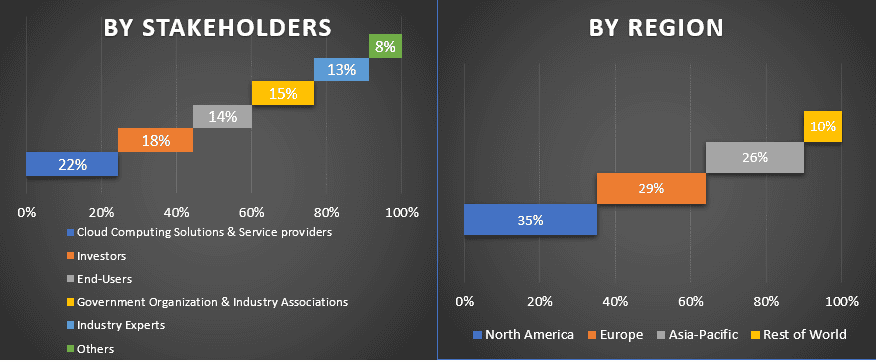- Home
- About Us
- Industry
- Services
- Reading
- Contact Us
Data Resiliency Market: Current Analysis and Forecast (2021-2027)
Emphasis on Type (Solutions and Services); Deployment (On-premises and Cloud); Organization Size (Large Enterprises and SMEs); Industry (Banking and Financial Services, Information and Communication Technology, Government, Media and Entertainment, Healthcare, and Others); and Region and Country

The data resiliency market is predicted to grow at a CAGR of around 17% during the forecast period. Key factors influencing the growth of the data resiliency market are the increasing adoption of cloud-based data backup and recovery solutions, increasing data safety concerns, and high growth in data generated throughout the years from various sources. For instance, it is expected that the world would generate over 180 zettabytes of data in 2025 while total data generated stood at around 64 zettabytes in 2020. All this data needs to be stored, processed, and secured with appropriate measures. A strong data resiliency strategy largely reduces the vulnerability of enterprise data, reducing the risk of critical data loss and minimizing the impact of downtime, outages, data breaches, and natural disasters. Thus, creating opportunities for the key market players in the data resiliency market.
Insights Presented in the Report
“Amongst type, solutions category held prominent market share in 2020”
Based on type, the market is segmented into solutions and services. In 2020, the solutions segment accounted for a significant share of the global data resiliency market. The growth of this segment is accounted to the increasing need for data backup and disaster recovery solutions. Data backup is the process of creating a copy of original data on a system or different location that is used in the case when original data is lost or corrupted. Data archiving is another important part of data resiliency solutions segment, data resiliency refers to the practice of identifying data no longer active or moving it out of the production systems into the long-term storage systems. Data is archived so that at any time it can be brought back into service. Data archiving is essential for businesses and organizations that acquire new data regularly yet must retain the currently stored data and remain able to quickly retrieve both types.
“Amongst deployment, On-premises category held prominent market share in 2020”
On the basis of deployment, the market is categorized into on-premises and cloud. Among these, on-premises held a prominent share in the revenue of the overall data resiliency market in 2020 and is expected to witness strong growth during the forecast period. Flexibility, data security, high speed, and low latency are the most prominent factors driving the growth of this segment. The on-premises deployment provides physical control to the enterprises over the data, it keeps access to critical data limited to the enterprises only. Moreover, enterprises do not have to rely on the internet to access any data from their database. However, the cloud deployment segment is expected to witness prominent growth during the forecast period, due to the low-cost, scalability, and increasing data security in cloud platforms. Furthermore, most enterprises are looking for a transition toward cloud services, providing opportunities to major cloud deployment data resiliency market players.
“APAC to showcase robust growth during the forecast period”
The APAC is projected to grow at a substantial rate during the forecast period. This can be attributed to the rise in cyber-attacks and ransomware attacks in this region. This has fueled the data resiliency market, positively influencing the data resiliency market in the region. In the APAC region, small and large enterprises use data resiliency to achieve business continuity in the event of data loss and failures. Moreover, the APAC region is one of the largest hubs for IT-BPM service and they need data resiliency most because the IT and software industry work with a lot of data. Furthermore, the banking and financial services industry is developing significantly, banks, in particular, have strengthened their balance sheets, making them more resilient to external shocks. According to the Asian Development Bank, the region’s middle-income economies have also made progress in developing the core of their domestic capital markets and non-banking sectors. The banking sector uses data resiliency to protect its critical data in order to get an uninterrupted business continuity.
Some of the major players operating in the market include Acronis International GmbH, Microsoft Corporation, Asigra Inc., International Business Machines Corporation, NetApp Inc., VMware Inc., Veritas Technologies LLC., Carbonite Inc., Hewlett Packard Enterprise, and Veeam Software AG among others.
Reasons to buy this report:
- The study includes market sizing and forecasting analysis validated by authenticated key industry experts
- The report presents a quick review of overall industry performance at one glance
- The report covers an in-depth analysis of prominent industry peers with a primary focus on key business financials, product portfolio, expansion strategies, and recent developments
- Detailed examination of drivers, restraints, key trends, and opportunities prevailing in the industry
- The study comprehensively covers the market across different segments
- Deep dive country-level analysis of the industry
Customization Options:
The global data resiliency market can further be customized as per the requirement or any other market segment. Besides this, UMI understands that you may have your own business needs, hence feel free to connect with us to get a report that completely suits your requirements.
Table of Content
Research Methodology for Global Data Resiliency Market Analysis (2021-2027)
Analyzing the historical market, estimating the current market, and forecasting the future market of data resiliency, three major steps are undertaken to create and analyze its adoption across the globe. Exhaustive secondary research was conducted to collect the historical market numbers and estimate the current market size. Secondly, to validate these insights, numerous findings and assumptions were taken into consideration. Moreover, exhaustive primary interviews were also conducted, with industry experts across the value chain of the data resiliency industry. Post assumption and validation of market numbers through primary interviews, we employed a bottom-up approach to forecast the complete market size. Thereafter, market breakdown and data triangulation methods were adopted to estimate and analyze the market size of segments and sub-segments of the industry pertains to. Detailed methodology is explained below:
Seek More Details About Research Methodology
Analysis of Historical Market Size
Step 1: In-Depth Study of Secondary Sources:
Detail secondary study was conducted to obtain the historical market size of data resiliency through company internal sources such as annual reports & financial statements, performance presentations, press releases, etc., and external sources including journals, news & articles, government publications, competitor publications, sector reports, third-party database, and other credible publications.
Step 2: Market Segmentation:
After obtaining the historical market size of the data resiliency market, we conducted a detailed secondary analysis to gather current market insights and share for different segments & sub-segments for major regions. The major segment is included in the report by type, deployment, organization size, and industry. Further regional and country-level analyses were conducted to evaluate the overall adoption of data resiliency globally.
Step 3: Factor Analysis:
After acquiring the historical market size of different segments and sub-segments, we conducted a detailed factor analysis to estimate the current market size of data resiliency. Further, we conducted factor analysis using dependent and independent variables such as the ability to process large amounts of data with speed and digitalization. A thorough analysis was conducted for demand and supply-side scenarios considering an increasing investment, top partnerships, mergers and acquisitions, business expansion, and product launches in the satellite transponders industry.
Seek More Details About Research Methodology
Current Market Size Estimate & Forecast
Current Market Sizing: Based on actionable insights from the above 3 steps, we arrived at the current market size, key players in the global data resiliency market, and market shares of each segment. All the required percentage shares split, and market breakdowns were determined using the above-mentioned secondary approach and were verified through primary interviews.
Estimation & Forecasting: For market estimation and forecast, weights were assigned to different factors including drivers & trends, restraints, and opportunities available for the stakeholders. After analyzing these factors, relevant forecasting techniques i.e., the bottom-up approach were applied to arrive at the market forecast to 2027 for different segments and subsegments across the major regions globally. The research methodology adopted to estimate the market size encompasses:
- The industry’s market size, in terms of value (US$) and the adoption rate of data resiliency across the major markets
- All percentage shares, splits, and breakdowns of market segments and sub-segments
- Key players in the data resiliency market. Also, the growth strategies adopted by these players to compete in the fast-growing market.
Market Size and Share Validation
Primary Research: In-depth interviews were conducted with the Key Opinion Leaders (KOLs) including Top Level Executives (CXO/VPs, Sales Head, Marketing Head, Operational Head, Regional Head, Country Head, etc.) across major regions. Primary research findings were then summarized, and statistical analysis was performed to prove the stated hypothesis. Inputs from primary research were consolidated with secondary findings, hence turning information into actionable insights.
Split of Primary Participants by Stakeholders and Regions

Seek More Details About Research Methodology
Market Engineering
The data triangulation technique was employed to complete the overall market estimation and to arrive at precise statistical numbers for each segment and sub-segment of the global data resiliency market. Data was split into several segments & sub-segments post studying various parameters and trends in the area of type, deployment, organization size, and industry.
The main objective of the data resiliency market study
The current & future market trends of global data resiliency were pinpointed in the study. Investors can gain strategic insights to base their discretion for investments on the qualitative and quantitative analysis performed in the study. Current and future market trends would determine the overall attractiveness of the market at a country level, providing a platform for the industrial participant to exploit the untapped market to benefit as a first-mover advantage. Other quantitative goals of the studies include:
- Analyze the current and forecast market size of data resiliency in terms of value (US$). Also, analyze the current and forecast market size of different segments and sub-segments
- Segment in the study include the area of type, deployment, organization size, and industry
- Defined analysis of the regulatory framework for the data resiliency industry
- Analyze the value chain involved with the presence of various intermediaries, along with analyzing customer and competitor behaviors of the industry
- Analyze the current and forecast market size of data resiliency for the major countries
- Major regions/countries analyzed in the report include North America (US, Canada, Rest of North America), Europe (Germany, UK, France, Italy, Spain, Rest of Europe), Asia-Pacific (China, Japan, India, Australia, Rest of Asia-Pacific), and Rest of World
- Company profiles of the data resiliency market players and the growth strategies adopted by them to sustain in the growing market
- Deep dive country-level analysis of the industry
Related Reports
Customers who bought this item also bought










